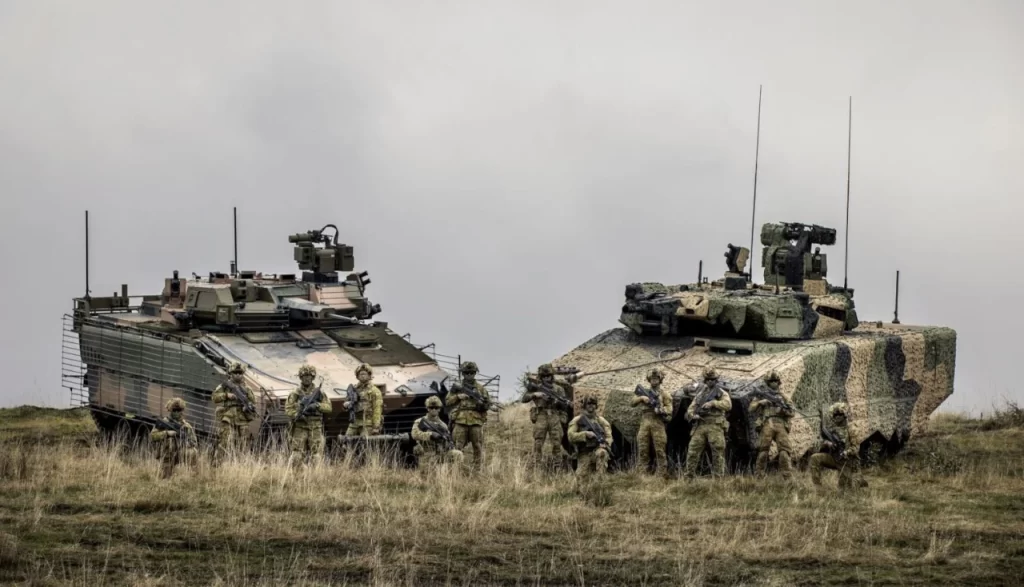The Australian Army’s ground forces are undergoing a significant change, and the purchase of the Infantry Fighting Vehicle (IFV) Hanwha AS21 Redback is a part of that transformation. More specifically, the programme LAND 400 focuses on replacing roughly 250 wheeled combat vehicles known as ASLAV (Australian Light Armoured Vehicle) and 400 tracked vehicles known as M113AS4.
The procurement of the Combat Reconnaissance Vehicle (CRV), the Infantry Fighting Vehicle (IFV), the Manoeuvre Support Vehicle (MSV), and the Integrated Training System (ITS) are all included in the LAND 400 programme.
The LAND 400 project can be broken down into four distinct stages. The specifications for the new vehicles’ duties and responsibilities were outlined in the LAND 400 Phase 1 document. The acquisition of the CRV was the focus of the project’s second phase (LAND 400 Phase 2). In 2018, Canberra placed an order with Rheinmetall for 211 Boxer-wheeled combat vehicles, specifically 133 of the CRV type. Armoured transporters without turrets equipped with automatic cannons and specialist variants make up the remainder of the fleet.
The IFVs and MSVs, the South Korean Redback vehicles, are being bought in the current third step (LAND 400 step 3). The ITS will be procured in the fourth and final step (LAND 400 step 4).
At first, Canberra asked for up to 450 tracked combat vehicles, which included 312 infantry fighting vehicles (IFVs), 26 command vehicles, 16 artillery observation vehicles, 11 vehicles for technical reconnaissance, 14 vehicles for technical support, 18 vehicles for repairs, 39 engineering vehicles, and 14 medical vehicles.
The significant reductions in spending directly result from the findings found in the strategy documents released in February, namely the National Defence: Defence Strategy Review 2023. According to the details in these documents, the People’s Republic of China is the most significant threat to Australia’s national security.
The buffer zone between Australia and China comprises hundreds of islands and millions of square kilometres of water. It begins at the most western point of Indonesia and extends to the most eastern section of Polynesia. The importance of air and naval forces cannot be overstated in this region. It is anticipated that the primary focus of the Australian ground forces will be on coastline (island) operations, and they will also take part in the destruction of naval targets.
According to the Defence Strategic Review 2023, new infantry fighting vehicles are required to complete the most difficult ground combat tasks successfully. The LAND 400 Phase 3 – Land Combat Vehicle System (Infantry Fighting Vehicle) vehicles must be decreased from 450 to 129, as stated in the paper, to meet the requirements. This will ensure that one mechanised battalion is present, particularly for coastal movements, and will also cover training, maintenance, and a combat reserve.

The authors of the document made it clear that the Army will only be able to achieve the strategic and operational effects required by the ADF (Australian Defence Force) for National Defence and the strategy of denial if it keeps these capabilities, namely the Independent Littoral Manoeuvre Vessel for coastal manoeuvring, the long-range strike – land-based strikes against naval targets, and IFVs.
In addition to the IFVs, the Australian ground forces plan to buy 17 MSVs built on the AS21 chassis. These vehicles will be used to overcome the obstacles the enemy has set up and help build protective fortifications.
The programme’s value goes from US $3.4 billion to $4.7 billion.
The fact that AS21 (K21 equipped with a 30mm calibre automatic cannon for the Land 400 Phase 3 IFV competition for the Australian Army) won is strange because South Korea offered K21 to the Polish Army. The Poles tried Korean IFV K21 with a 40mm cannon, but it didn’t work out well. Because the prototype had technical problems and a faulty design, Poland decided not to buy AS21. But in Australia, three AS21 versions that seemed to be different did much better.
The strategic documents state that the 20 M142 HIMARS (High Mobility Artillery Rocket Systems) rocket launchers bought in January will give the Australian Army better long-range firepower. The price for this deal is 385 million US dollars. Naval targets can also be hit with the latest and best ammo for the HIMARS rocket launchers.
Additionally, two weeks ago, Germany purchased a hundred “indigenous” Boxer HWC (Heavy Weapon Carrier) wheeled armoured transporters from Australia. These German vehicles are manufactured in Queensland under the contract mentioned above for supplying Boxers to the Australian Army.
In addition, the German government recently completed the purchase of one hundred “indigenous” Boxer HWC (Heavy Weapon Carrier) wheeled armoured transports from the Australian government. Following the previously specified deal, these German-made vehicles are manufactured in Queensland to provide Boxers to the Australian Army.
Prime Minister Anthony Albanese, who was present in Berlin to witness the contract signing, noted that the transaction was one of the largest in the history of Australia’s defence industry, with a value of more than one billion dollars for the economy of Australia.
When the conflict in Ukraine led European countries to replenish their military equipment, the export deal for German military technology back to Germany came about. Because European armament producers cannot keep up with demand, the nations of Europe are forced to purchase weaponry and ammunition from other countries worldwide.
